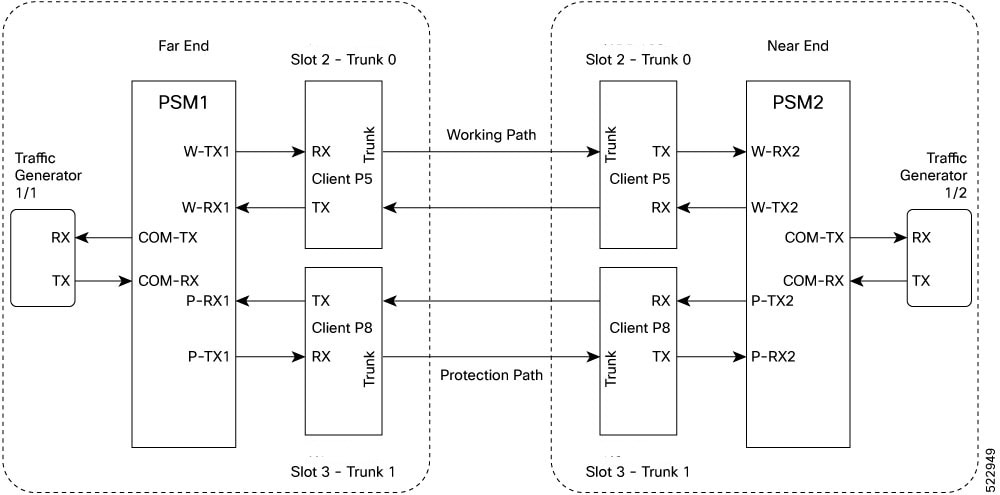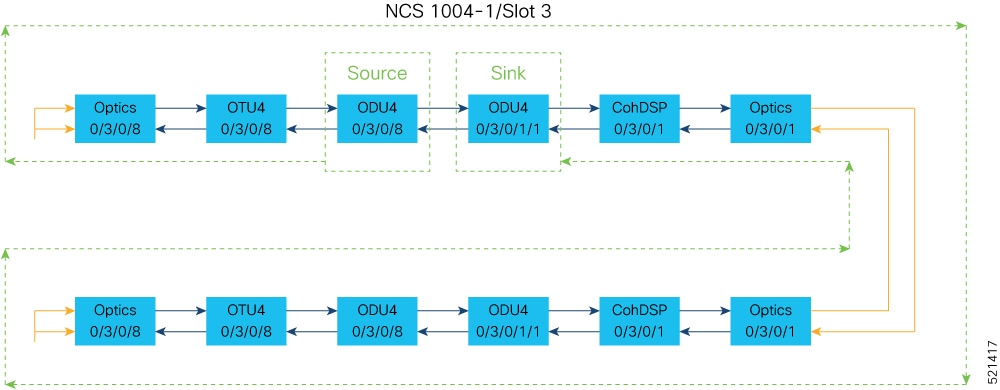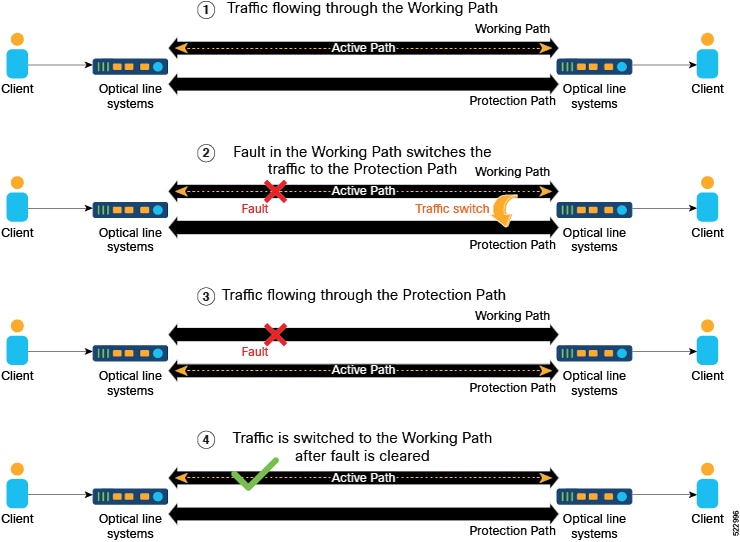AINS
The Automatic-In-Service (AINS) feature allows the controller to automatically move to the automatic-in-service state after the maintenance window is completed. A soak time period is associated with the AINS state. The controller automatically moves to the In-Service state after the soak time period is completed. During the AINS maintenance window, alarms are not propagated to the EMS/NMS monitoring system.
You can configure AINS on the client ports of the card.
AINS States
The following table lists the AINS states.
|
State |
Description |
|---|---|
|
None |
AINS is not enabled on the controller or the soak time period is complete. |
|
Pending |
AINS is configured on the controller. However, the soak time period has not started because either the primary state of controller is in Shutdown, Admin down, or Not ready state or the secondary state is in Maintenance state. AINS can also move to Pending state if alarms are raised during the soak time period. |
|
Running |
AINS is enabled on the controller. The primary state of the controller is Up and the secondary state is AINS. |
If there are any service-affecting alarms when AINS is runring on ethernet or optics controllers, the AINS state moves to Pending state. When the alarms are cleared, the AINS state moves to Running state.
The AINS soak time period restarts when there are line card reloads, XR reloads, line card warm reloads, power cycles, or alarm conditioning.
Soak Time Period
You can configure the soak time period to be between 1 minute to 48 hours.
All alarms are suppressed during the AINS state. When the optical and ethernet alarms are raised on the port during the soak time period, the AINS state moves to Pending. These alarms are not displayed in the output of the show alarms brief card location 0/RP0/CPU0 active command but in the output of the show alarms brief card location 0/RP0/CPU0 conditions command. When all the alarms clear, the soak time period starts, and the AINS state moves to Running. When the soak time period expires, the port moves to IS state.
Configuring AINS
To configure AINS on a muxponder, use the following command:
configure
hw-module location location mxponder client-port-ains-soak hours hours minutes minutes
commit
The following is a sample in which all client ports are configured with AINS with soak time period specified to be 15 minutes.
RP/0/RP0/CPU0:ios#configure
RP/0/RP0/CPU0:ios(config)#hw-module location 0/3 mxponder client-port-ains-soak hours 0 minutes 15
RP/0/RP0/CPU0:ios(config)#commit
To configure AINS on a muxponder slice, use the following command:
configure
hw-module location location mxponder-slice slice-number client-port-ains-soak hours hours minutes minutes
commit
The following is a sample in which slice 0 client ports are configured with AINS with soak time period specified to be 40 minutes.
RP/0/RP0/CPU0:ios#configure
RP/0/RP0/CPU0:ios(config)#hw-module location 0/3 mxponder-slice 0 client-port-ains-soak hours 0 minutes 40
RP/0/RP0/CPU0:ios(config)#commit
Disabling AINS
To disable AINS on all muxponder client ports, set the hours and minutes to 0. Use the following commands:
configure
hw-module location location mxponder client-port-ains-soak hours hours minutes minutes
commit
The following is a sample in which AINS is disabled on all client ports.
RP/0/RP0/CPU0:ios#configure
RP/0/RP0/CPU0:ios(config)#hw-module location 0/3 mxponder client-port-ains-soak hours 0 minutes 0
RP/0/RP0/CPU0:ios(config)#commit
To disable AINS on a muxponder slice, set the hours and minutes to 0. Use the following command:
configure
hw-module location location mxponder-slice slice-number client-port-ains-soak hours hours minutes minutes
commit
The following is a sample in which AINS is disabled on all client ports of slice 0.
RP/0/RP0/CPU0:ios#configure
RP/0/RP0/CPU0:ios(config)#hw-module location 0/3 mxponder-slice 0 client-port-ains-soak hours 0 minutes 0
RP/0/RP0/CPU0:ios(config)#commit
Displaying the AINS Configuration
The AINS Soak field in the output indicates the current state of AINS. The current state can be None, Pending, or Running. The Total Duration field indicates the total soak time period that is configured. The Remaining Duration field indicates the soak time that remains, after which, the AINS state moves to None.
This example displays the ethernet controller statistics with AINS Soak in running state.
RP/0/RP0/CPU0:ios#show controller HundredGigECtrlr 0/1/0/2Thu Feb 21 19:52:55.001 UTC
Operational data for interface HundredGigECtrlr0/1/0/2:
State:
Administrative state: enabled
Operational state: Up
LED state: Green On
Maintenance: Disabled
AINS Soak: Running
Total Duration: 0 hour(s) 15 minute(s)
Remaining Duration: 0 hour(s) 5 minute(s) 37 second(s)
Laser Squelch: Disabled
Phy:
Media type: Not known
Autonegotiation disabled.
Operational values:
Speed: 100Gbps
Duplex: Full Duplex
Flowcontrol: None
Loopback: None (or external)
BER monitoring:
Not supported
Holdoff Time: 0ms
This example displays the ethernet controller statistics with AINS Soak in pending state.
RP/0/RP0/CPU0:ios#show controllers HuC 0/0/0/2
Thu Mar 12 13:52:12.129 UTC
Operational data for interface HundredGigECtrlr0/0/0/2:
State:
Administrative state: enabled
Operational state: Down (Reason: State undefined)
LED state: Red On
Maintenance: Disabled
AINS Soak: Pending
Total Duration: 0 hour(s) 30 minute(s)
Remaining Duration: 0 hour(s) 30 minute(s) 0 second(s)
Laser Squelch: Disabled
Phy:
Media type: Not known
Alarms:
Current:
Local Fault
Statistics:
FEC:
Corrected Codeword Count: 0
Uncorrected Codeword Count: 9
Autonegotiation disabled.
Operational values:
Speed: 100Gbps
Duplex: Full Duplex
Flowcontrol: None
Loopback: None (or external)
BER monitoring:
Not supported
Forward error correction: Standard (Reed-Solomon)
Holdoff Time: 0ms
This example displays the optics controller statistics with AINS Soak in running state.
RP/0/RP0/CPU0:ios#show controller optics 0/1/0/3Thu Feb 21 19:45:41.088 UTC
Controller State: Up
Transport Admin State: Automatic In Service
Laser State: On
LED State: Green
Optics Status
Optics Type: Grey optics
Alarm Status:
-------------
Detected Alarms: None
LOS/LOL/Fault Status:
Alarm Statistics:
-------------
HIGH-RX-PWR = 0 LOW-RX-PWR = 0
HIGH-TX-PWR = 0 LOW-TX-PWR = 0
HIGH-LBC = 0 HIGH-DGD = 0
OOR-CD = 0 OSNR = 0
WVL-OOL = 0 MEA = 0
IMPROPER-REM = 0
TX-POWER-PROV-MISMATCH = 0
Performance Monitoring: Enable
THRESHOLD VALUES
----------------
Parameter High Alarm Low Alarm High Warning Low Warning
------------------------ ---------- --------- ------------ -----------
Rx Power Threshold(dBm) 4.9 -12.0 0.0 0.0
Tx Power Threshold(dBm) 3.5 -10.1 0.0 0.0
LBC Threshold(mA) N/A N/A 0.00 0.00
LBC High Threshold = 98 %
Polarization parameters not supported by optics
Total TX Power = 6.39 dBm
Total RX Power = 5.85 dBm
Lane Laser Bias TX Power RX Power Output Frequency
---- ---------- ---------- ---------- ----------------
1 75.0 % 0.59 dBm 0.63 dBm 230.43 THz
2 68.6 % 0.06 dBm -0.68 dBm 230.43 THz
3 69.0 % 0.26 dBm -0.63 dBm 230.43 THz
4 69.1 % 0.56 dBm -0.10 dBm 230.43 THz
Transceiver Vendor Details
Form Factor : QSFP28
Name : CISCO-FINISAR
Part Number : FTLC1152RGPL-C2
Rev Number : CISCO-FINISAR
Serial Number : FNS22150LEC
PID : QSFP-100G-CWDM4-S
VID : V02
CISCO-FINISAR
Date Code(yy/mm/dd) : 18/04/11
Fiber Connector Type: LC
Sonet Application Code: Not Set
Ethernet Compliance Code: 100GBASE-CWDM4
Transceiver Temperature : 32 Celsius
AINS Soak : Running
AINS Timer : 0h, 15m
AINS remaining time : 771 seconds
When the soak time expires, AINS state changes from Running to None. The Transport Admin State of optics controller changes from Automatic In Service to In Service.
RP/0/RP0/CPU0:ios# show controllers optics 0/1/0/3
Thu Feb 21 20:02:34.126 UTC
Controller State: Up
Transport Admin State: In Service
Laser State: On
LED State: Green
Optics Status
Optics Type: Grey optics
Alarm Status:
-------------
Detected Alarms: None
LOS/LOL/Fault Status:
Alarm Statistics:
-------------
HIGH-RX-PWR = 0 LOW-RX-PWR = 0
HIGH-TX-PWR = 0 LOW-TX-PWR = 0
HIGH-LBC = 0 HIGH-DGD = 0
OOR-CD = 0 OSNR = 0
WVL-OOL = 0 MEA = 0
IMPROPER-REM = 0
TX-POWER-PROV-MISMATCH = 0
Performance Monitoring: Enable
THRESHOLD VALUES
----------------
Parameter High Alarm Low Alarm High Warning Low Warning
------------------------ ---------- --------- ------------ -----------
Rx Power Threshold(dBm) 4.9 -12.0 0.0 0.0
Tx Power Threshold(dBm) 3.5 -10.1 0.0 0.0
LBC Threshold(mA) N/A N/A 0.00 0.00
LBC High Threshold = 98 %
Polarization parameters not supported by optics
Total TX Power = 6.41 dBm
Total RX Power = 5.85 dBm
Lane Laser Bias TX Power RX Power Output Frequency
---- ---------- ---------- ---------- ----------------
1 74.9 % 0.60 dBm 0.63 dBm 230.43 THz
2 68.6 % 0.06 dBm -0.70 dBm 230.43 THz
3 69.0 % 0.30 dBm -0.63 dBm 230.43 THz
4 69.1 % 0.57 dBm -0.11 dBm 230.43 THz
Transceiver Vendor Details
Form Factor : QSFP28
Name : CISCO-FINISAR
Part Number : FTLC1152RGPL-C2
Rev Number : CISCO-FINISAR
Serial Number : FNS22150LEC
PID : QSFP-100G-CWDM4-S
VID : V02
CISCO-FINISAR
Date Code(yy/mm/dd) : 18/04/11
Fiber Connector Type: LC
Sonet Application Code: Not Set
Ethernet Compliance Code: 100GBASE-CWDM4
Transceiver Temperature : 32 Celsius
AINS Soak : None
AINS Timer : 0h, 0m
AINS remaining time : 0 seconds
Configuring AINS on OTN-XP Card
You can configure the default AINS settings for all controllers on the OTN-XP card using the shared plane configuration. The configuration is applied to any line card that is installed in the NCS 1004. Use the following commands:
configure
ains-soak hours hours minutes minutes
commit
The following is a sample in which all the controllers on the OTN-XP card are configured with AINS with soak time period specified to be two minutes.
RP/0/RP0/CPU0:ios#configure
RP/0/RP0/CPU0:ios(config)#ains-soak hours 0 minutes 2
RP/0/RP0/CPU0:ios(config)#commit
RP/0/RP0/CPU0:ios(config)#do show controllers optics 0/1/0/0
Tue Apr 28 11:50:15.431 UTC
Controller State: Down
Transport Admin State: Automatic In Service
Laser State: On
LED State: Red
Optics Status
Optics Type: 100G QSFP28 LR4
Alarm Status:
-------------
Detected Alarms: None
LOS/LOL/Fault Status:
Alarm Statistics:
-------------
HIGH-RX-PWR = 0 LOW-RX-PWR = 0
HIGH-TX-PWR = 0 LOW-TX-PWR = 0
HIGH-LBC = 0 HIGH-DGD = 0
OOR-CD = 0 OSNR = 0
WVL-OOL = 0 MEA = 0
IMPROPER-REM = 0
TX-POWER-PROV-MISMATCH = 0
Performance Monitoring: Enable
THRESHOLD VALUES
----------------
Parameter High Alarm Low Alarm High Warning Low Warning
------------------------ ---------- --------- ------------ -----------
Rx Power Threshold(dBm) 4.9 -12.0 0.0 0.0
Tx Power Threshold(dBm) 3.5 -10.1 0.0 0.0
LBC Threshold(mA) N/A N/A 0.00 0.00
LBC High Threshold = 98 %
Polarization parameters not supported by optics
Total TX Power = 7.74 dBm
Total RX Power = -40.00 dBm
Lane Laser Bias TX Power RX Power Output Frequency
---- ---------- ---------- ---------- ----------------
1 67.2 % 1.85 dBm -40.00 dBm 231.39 THz
2 67.9 % 1.55 dBm -40.00 dBm 230.59 THz
3 67.5 % 1.58 dBm -40.00 dBm 229.79 THz
4 66.8 % 1.89 dBm -40.00 dBm 230.25 THz
Transceiver Vendor Details
Form Factor : QSFP28
Name : CISCO-FINISAR
Part Number : 10-3204-01
Rev Number : B
Serial Number : FNS20510YUB
PID : ONS-QSFP28-LR4
VID : V01
Date Code(yy/mm/dd) : 16/12/15
Fiber Connector Type: LC
Otn Application Code: 4I1-9D1F
Sonet Application Code: Not Set
Ethernet Compliance Code: 100GBASE-LR4
Transceiver Temperature : 27 Celsius
AINS Soak : Pending
AINS Timer : 0h, 2m
AINS remaining time : 120 seconds
To override the default AINS settings on a specific controller, use the following commands:
automatic-in-service controller optics R/S/I/P hours hours minutes minutes
 Note |
This configuration does not persist after an RP reload operation. |
The following is a sample in which the optics controller on the OTN-XP card is configured with a soak time period of 45 minutes.
RP/0/RP0/CPU0:ios#automatic-in-service controller optics 0/1/0/0 hours 0 minutes 45
Tue Apr 28 11:55:15.666 UTC
RP/0/RP0/CPU0:ios#show controllers optics 0/1/0/0
Tue Apr 28 11:55:30.323 UTC
Controller State: Down
Transport Admin State: Automatic In Service
Laser State: On
LED State: Red
Optics Status
Optics Type: 100G QSFP28 LR4
Alarm Status:
-------------
Detected Alarms: None
LOS/LOL/Fault Status:
Alarm Statistics:
-------------
HIGH-RX-PWR = 0 LOW-RX-PWR = 0
HIGH-TX-PWR = 0 LOW-TX-PWR = 0
HIGH-LBC = 0 HIGH-DGD = 0
OOR-CD = 0 OSNR = 0
WVL-OOL = 0 MEA = 0
IMPROPER-REM = 0
TX-POWER-PROV-MISMATCH = 0
Performance Monitoring: Enable
THRESHOLD VALUES
----------------
Parameter High Alarm Low Alarm High Warning Low Warning
------------------------ ---------- --------- ------------ -----------
Rx Power Threshold(dBm) 4.9 -12.0 0.0 0.0
Tx Power Threshold(dBm) 3.5 -10.1 0.0 0.0
LBC Threshold(mA) N/A N/A 0.00 0.00
LBC High Threshold = 98 %
Polarization parameters not supported by optics
Total TX Power = 7.74 dBm
Total RX Power = -40.00 dBm
Lane Laser Bias TX Power RX Power Output Frequency
---- ---------- ---------- ---------- ----------------
1 67.2 % 1.85 dBm -40.00 dBm 231.39 THz
2 67.9 % 1.55 dBm -40.00 dBm 230.59 THz
3 67.5 % 1.58 dBm -40.00 dBm 229.79 THz
4 66.8 % 1.89 dBm -40.00 dBm 230.25 THz
Transceiver Vendor Details
Form Factor : QSFP28
Name : CISCO-FINISAR
Part Number : 10-3204-01
Rev Number : B
Serial Number : FNS20510YUB
PID : ONS-QSFP28-LR4
VID : V01
Date Code(yy/mm/dd) : 16/12/15
Fiber Connector Type: LC
Otn Application Code: 4I1-9D1F
Sonet Application Code: Not Set
Ethernet Compliance Code: 100GBASE-LR4
Transceiver Temperature : 27 Celsius
AINS Soak : Pending
AINS Timer : 0h, 45m
AINS remaining time : 2700 seconds
From Release 7.5.2 onwards, AINS is supported on the 16G FC and 32FC controllers.
The following is a sample to configure AINS in 16G FC controller.
RP/0/RP0/CPU0:ios#configure
RP/0/RP0/CPU0:ios(config)#automatic-in-service controller SixteenGigFibreChanCtrlr 0/0/0/6/2 hours 0 minutes 15
RP/0/RP0/CPU0:ios(config)#commitThe following is a sample to verify AINS in 16G FC controller.
show controllers SixteenGigFibreChanCtrlr 0/0/0/6/2 on XR
+++ 15:04:25 ne(default) exec +++
show controllers SixteenGigFibreChanCtrlr 0/0/0/6/2
Wed Apr 13 15:04:25.206 UTC
Operational data for Fibre Channel controller SixteenGigFibreChanCtrlr0/0/0/6/2
State:
Admin State : Up
Operational state : Up
LED state : Green On
Secondary admin state : Automatic In Service
AINS Soak : Running
Total Duration : 0 hour(s) 15 minute(s)
Remaining Duration: 0 hour(s) 14 minute(s) 29 second(s)
Laser Squelch : Disabled
Performance Monitoring is enabled
Operational values:
Speed : 16 Gbps
Loopback : None
BER monitoring:
Not supported
Hold-off Time : 0 ms
Forward Error Correction : Not Configured
The following is a sample to configure AINS in 32G FC controller.
RP/0/RP0/CPU0:ios#configure
RP/0/RP0/CPU0:ios(config)#automatic-in-service controller ThirtyTwoGigFibreChanCtrlr 0/0/0/0/4 hours 0 minutes 15
RP/0/RP0/CPU0:ios(config)#commitThe following is a sample to verify AINS in 32G FC controller.
show controllers ThirtyTwoGigFibreChanCtrlr 0/0/0/0/4 on XR
+++ 15:04:25 ne(default) exec +++
show controllers ThirtyTwoGigFibreChanCtrlr 0/0/0/0/4
Wed Apr 13 15:04:25.393 UTC
Operational data for Fibre Channel controller ThirtyTwoGigFibreChanCtrlr0/0/0/0/4
State:
Admin State : Up
Operational state : Up
LED state : Green On
Secondary admin state : Automatic In Service
AINS Soak : Running
Total Duration : 0 hour(s) 15 minute(s)
Remaining Duration: 0 hour(s) 14 minute(s) 29 second(s)
Laser Squelch : Disabled
Performance Monitoring is enabled
Operational values:
Speed : 32 Gbps
Loopback : None
BER monitoring:
Not supported
Hold-off Time : 0 ms
Forward Error Correction : Standard(Reed Solomon)
RP/0/RP0/CPU0:ne#From Release 7.5.2 onwards, AINS is supported on the controllers for OTUCn-REGEN mode.
The following is a sample to configure AINS on the coherentDSP controllers for OTUCn-REGEN mode.
RP/0/RP0/CPU0:ios#automatic-in-service controller coherentDSP 0/0/0/12 hours 0 minutes 15
Tue May 24 17:51:06.979 UTC
The following sample verifies the AINS configured on the coherentDSP controllers for OTUCn-REGEN mode.
RP/0/RP0/CPU0:ios#show controllers coherentDSP 0/0/0/12
Tue May 24 17:52:29.558 UTC
Port : CoherentDSP 0/0/0/12
Controller State : Up
Inherited Secondary State : Automatic-In-Service
Configured Secondary State : Automatic-In-Service
Derived State : Automatic-In-Service
Loopback mode : None
BER Thresholds : SF = 1.0E-5 SD = 1.0E-7
Performance Monitoring : Enable
Bandwidth : 400.0Gb/s
Alarm Information:
LOS = 0 LOF = 0 LOM = 0
OOF = 4 OOM = 0 AIS = 3
IAE = 0 BIAE = 0 SF_BER = 0
SD_BER = 0 BDI = 3 TIM = 1
FECMISMATCH = 0 FEC-UNC = 0 FLEXO_GIDM = 2
FLEXO-MM = 0 FLEXO-LOM = 0 FLEXO-RDI = 2
FLEXO-LOF = 0
Detected Alarms : None
Bit Error Rate Information
PREFEC BER : 1.42E-04
POSTFEC BER : 0.00E+00
Q-Factor : 11.10 dB
Q-Margin : 4.60dB
TTI :
Remote hostname : ios
Remote interface : CoherentDSP 0/0/0/12
Remote IP addr : 0.0.0.0
FEC mode : O_FEC
Flexo-Mode : Enable
Flexo Details:
Tx GID : 10
TX IID : 1, 2, 3, 4,
Rx GID : 10
RX IID : 1, 2, 3, 4,
AINS Soak : Running
AINS Timer : 0h, 15m
AINS remaining time : 855 seconds
The following is a sample to configure AINS globally on the OTUCn-REGEN mode.
RP/0/RP0/CPU0:ios#configure terminal
Tue May 24 17:51:34.545 UTC
RP/0/RP0/CPU0:ios(config)#ains-soak hours 0 minutes 15
RP/0/RP0/CPU0:ios(config)#commit
Tue May 24 17:51:44.144 UTC
The following sample verifies the AINS configured on the coherentDSP controllers:
RP/0/RP0/CPU0:ios#show controllers optics 0/0/0/12
Tue May 24 17:52:34.445 UTC
Controller State: Up
Transport Admin State: Automatic In Service
Laser State: On
LED State: Green
Optics Status
Optics Type: CFP2 DWDM
DWDM carrier Info: C BAND, MSA ITU Channel=61, Frequency=193.10THz,
Wavelength=1552.524nm
Alarm Status:
-------------
Detected Alarms: None
LOS/LOL/Fault Status:
Alarm Statistics:
-------------
HIGH-RX-PWR = 0 LOW-RX-PWR = 0
HIGH-TX-PWR = 0 LOW-TX-PWR = 0
HIGH-LBC = 0 HIGH-DGD = 0
OOR-CD = 0 OSNR = 1
WVL-OOL = 0 MEA = 0
IMPROPER-REM = 0
TX-POWER-PROV-MISMATCH = 0
Laser Bias Current = 0.0 %
Actual TX Power = 0.47 dBm
RX Power = 0.40 dBm
RX Signal Power = 0.30 dBm
Frequency Offset = -1358 MHz
Performance Monitoring: Enable
THRESHOLD VALUES
----------------
Parameter High Alarm Low Alarm High Warning Low Warning
------------------------ ---------- --------- ------------ -----------
Rx Power Threshold(dBm) 3.0 -25.5 0.0 0.0
Tx Power Threshold(dBm) 3.0 -12.0 0.0 0.0
LBC Threshold(mA) N/A N/A 0.00 0.00
LBC High Threshold = 90 %
Configured Tx Power = 0.50 dBm
Configured CD High Threshold = 48000 ps/nm
Configured CD lower Threshold = -48000 ps/nm
Configured OSNR lower Threshold = 22.00 dB
Configured DGD Higher Threshold = 67.00 ps
Baud Rate = 63.1394679230 GBd
Bits per Symbol = 4.0000000000 bits/symbol
Modulation Type: 16QAM
Chromatic Dispersion -1 ps/nm
Configured CD-MIN -24000 ps/nm CD-MAX 24000 ps/nm
Polarization Mode Dispersion = 0.0 ps
Second Order Polarization Mode Dispersion = 52.00 ps^2
Optical Signal to Noise Ratio = 35.90 dB
SNR = 19.40 dB
Polarization Dependent Loss = 1.70 dB
Polarization Change Rate = 0.00 rad/s
Differential Group Delay = 2.00 ps
DAC RATE: 1x1.50
Transceiver Vendor Details
Form Factor : CFP2
Name : CISCO-ACACIA
Part Number : 10-3555-01
Rev Number : A0
Serial Number : ACA25420007
PID : DP04CFP2-M25-K9
VID : VES1
Date Code(yy/mm/dd) : 21/09/28
Fiber Connector Type: LC
Otn Application Code: Not Set
Sonet Application Code: Not Set
Ethernet Compliance Code: Not set
Transceiver Temperature : 41 Celsius
AINS Soak : Running
AINS Timer : 0h, 15m
AINS remaining time : 850 seconds







 Feedback
Feedback